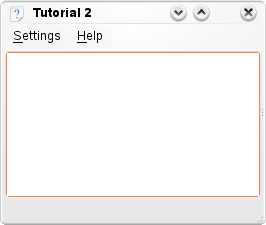Development/Tutorials/Using KXmlGuiWindow (es)
Development/Tutorials/Using_KXmlGuiWindow
Languages: عربي | Asturianu | Català | Česky | Kaszëbsczi | Dansk | Deutsch | English | Esperanto | Español | Eesti | فارسی | Suomi | Français | Galego | Italiano | 日本語 | 한국어 | Norwegian | Polski | Português Brasileiro | Română | Русский | Svenska | Slovenčina | Slovenščina | српски | Türkçe | Tiếng Việt | Українська | 简体中文 | 繁體中文
| Serie | Tutorial para principiantes |
| Requisitos previos | Tutorial 1 - Hola Mundo |
| Siguiente | Tutorial 3 - KActions y XMLGUI |
| Lectura avanzada | KXmlGuiWindow |
Resumen
Este tutorial continua el camino iniciado por el tutorial Hola Mundo, haciendo una introducción a la clase KXmlGuiWindow.
En el tutorial anterior, el programa mostró una "caja de diálogo" (dialog box), ahora vamos a añadir mas funcionalidad al programa.

KXmlGuiWindow
La clase KXmlGuiWindow proporciona una vista de la venta principal con una barra de menú, una barra de herramientas, una barra de estado y un área principial en el centro del widget. La mayoria de las aplicaciones de KDE derivarán de esta clase, que proporciona una manera facil de definir el layout del menú y la barra de herramientas mediante archivos XML (esta tecnología se llama XMLGUI). Si bien no usaremos XMLGUI en este tutorial, lo haremos en el siguiente.
Con el fin de tener un KXmlGuiWindow que pueda usarse, debemos heredar de él. Por lo que creamos dos archivos, mainwindow.cpp y mainwindow.h que contendrán nuestro código.
mainwindow.h
- ifndef MAINWINDOW_H
- define MAINWINDOW_H
- include <KXmlGuiWindow>
- include <KTextEdit>
class MainWindow : public KXmlGuiWindow
{
public:
MainWindow(QWidget *parent=0);
private:
KTextEdit* textArea;
};
- endif
First we Subclass KXmlGuiWindow on line 7 with class MainWindow : public KXmlGuiWindow.
Then we declare the constructor with MainWindow(QWidget *parent=0);.
And finally we declare a pointer to the object that will make up the bulk of our program. KTextEdit is a generic richtext editor with some KDE niceties like cursor auto-hiding.
mainwindow.cpp
- include "mainwindow.h"
MainWindow::MainWindow(QWidget *parent) : KXmlGuiWindow(parent)
{
textArea = new KTextEdit();
setCentralWidget(textArea);
setupGUI();
}
First, of course, on line 1 we have to include the header file containing the class declaration.
On line 5, we initialise our text editor with an object. Then on line 6 we use KXmlGuiWindow's built-in setCentralWidget() function which tells the KXmlGuiWindow what should appear in the central section of the window.
Finally, KXmlGuiWindow::setupGUI() is called which does a lot of behind-the-scenes stuff and creates the default menu bars (Settings, Help).
Actualizando main.cpp
Con el fin de ejecutar esta ventana, necesitamos añadir unas pocas lineas a main.cpp:
main.cpp
- include <KApplication>
- include <KAboutData>
- include <KCmdLineArgs>
- include "mainwindow.h"
int main (int argc, char *argv[])
{
KAboutData aboutData( "tutorial2", 0,
ki18n("Tutorial 2"), "1.0",
ki18n("A simple text area"),
KAboutData::License_GPL,
ki18n("Copyright (c) 2007 Developer") );
KCmdLineArgs::init( argc, argv, &aboutData );
KApplication app;
MainWindow* window = new MainWindow();
window->show();
return app.exec();
}
The only new lines here (compared to Tutorial 1) are 5, 18 and 19. On line 18, we create our MainWindow object and then on line 19, we display it.
CMake
La mejor manera de compilar el programa es usar CMake. Lo único que ha cambiado desde el tutorial 1 es que hemos añadido mainwindow.cpp a la lista de fuentes y hemos cambiado tutorial1 por tutorial2.
CMakeLists.txt
project (tutorial2)
find_package(KDE4 REQUIRED)
include_directories(${KDE4_INCLUDES})
set(tutorial2_SRCS
main.cpp
mainwindow.cpp
)
kde4_add_executable(tutorial2 ${tutorial2_SRCS})
target_link_libraries(tutorial2 ${KDE4_KDEUI_LIBS})
Compilando
Para compilarlo, enlazarlo y ejecutarlo, usa:
mkdir build && cd build cmake .. make ./tutorial2
Avanzando
Ahora puedes continuar con el Tutorial 3 - Usar KActions.
